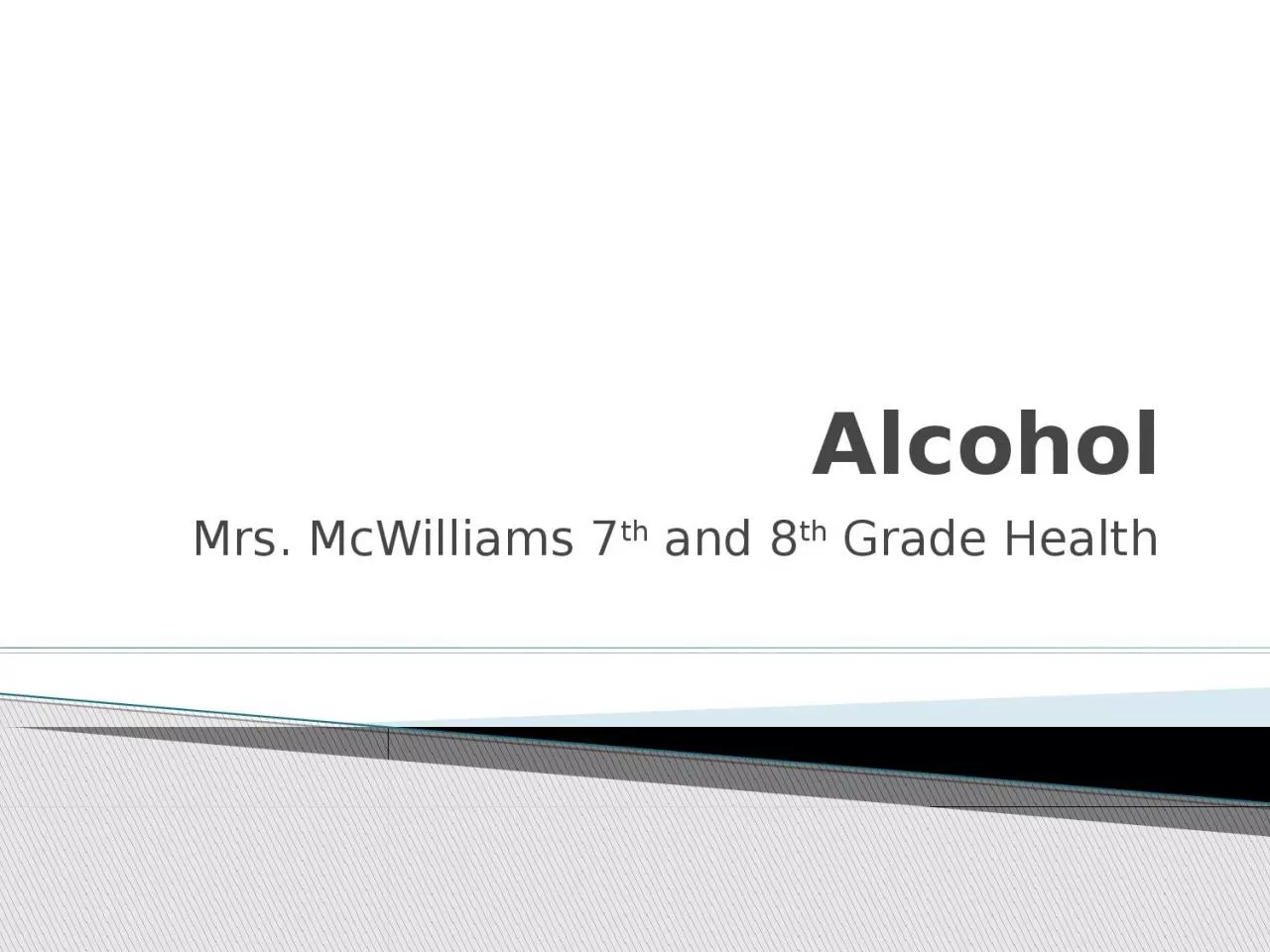

th and 8 th Grade Health Depressant Contains an intoxicating substance called ethyl alcohol or ethanol Produced by the fermentation process The anaerobic no oxygen conversion of sugar to carbon dioxide and alcohol by yeast ID: 918765
Download Presentation The PPT/PDF document "Alcohol Mrs. McWilliams 7" is the property of its rightful owner. Permission is granted to download and print the materials on this web site for personal, non-commercial use only, and to display it on your personal computer provided you do not modify the materials and that you retain all copyright notices contained in the materials. By downloading content from our website, you accept the terms of this agreement.
Slide1
Alcohol
Mrs. McWilliams 7
th
and 8
th
Grade Health
Slide2Depressant
Contains an intoxicating substance called ethyl alcohol or ethanol
Produced by the fermentation processThe anaerobic (no oxygen) conversion of sugar to carbon dioxide and alcohol by yeast.
What is Alcohol?
Slide3The concentration of alcohol in a beverage is the proof value
Proof value = 2X percentage alcohol.
Example: 100 proof (whiskey) contains 50% alcohol
Slide412 oz beer
5 oz wine
Mixed drink with 1.5 oz of 80 proof liquor (40% alcohol)
Current recommendations are:
1 drink/day for women
2 drinks/day for men
ONE DRINK =
0.6 oz alcohol
Slide5Alcohol Use Patterns in the USA
1/3 are abstainers
2/3 are drinkers
1/3 are light drinkers
1/3 are moderate/heavy drinkers
10% of the drinking population is considered heavy drinkers- they are responsible for 50% of all alcohol consumption in the US!
Annual Sales of alcohol average out to roughly 2.3 gallons of absolute alcohol per person!
Slide6Absorption and Metabolism
20% rapidly absorbed into bloodstream
75 % through upper part of the small intestine and the rest enters further along in the intestinal tract.
Metabolism of alcohol is in the liver.
2-10% is not metabolized but is excreted through the sweat glands, lungs and kidneys.
Slide7Factors that Affect Alcohol Absorption
Strength of the
beverage
Number of drinks
consumed
Speed of consumption
Presence of food in stomach
Physical
tolerance
Slide8Blood Alcohol Concentration
Percentage of alcohol in a measured amount of blood
Measured from exhaled breath or blood sample
Slide9Slide10Slide11Possible consequences of frequent alcohol use
Slide12Drinking alcohol impairs vision, reaction time, and coordination.
DWI and DUI –leading cause of death among teensSigns of intoxication can begin to appear as low as 0.02
There is no acceptable BAC level for anyone under 21
Drinking and Driving
Slide13Slide14Slide15Normal healthy liver
Liver with cirrhosis
Slide16Fetal Alcohol Syndrome
Fetus is exposed to alcohol in a slower manner than an adult
Damage results in mental retardation
Other characteristics are low birth weight, facial abnormalities, widely spaced eyes, and a much smaller head
Full expression rate: 1-3 out of 1000 births
Partial expression rate: 3-9/100 births
Slide17Fetal Alcohol Syndrome Characteristics
Slide18Slide19Alcoholism- different patterns
Regular daily intake of large amounts
Regular heavy drinking limited to weekends
Long periods of sobriety interspersed with periods of binge drinking lasting weeks or months
Heavy drinking limited to periods of stress
Slide20Who Wants to be a Millionaire?
Alcohol Edition
Slide21A major factor in traffic accidents, homicides, and suicides for 16 to 24 year olds is
a. alcohol use
b. smoking cigarettes
c. affiliation with gangs d. psychological disorders
$100 Question
Slide22a. Alcohol Use
$100 Answer
Slide23Teens often choose to drink because they think it
Increases their self confidence
sharpens perceptions
enhances memory
improves judgment
$200 Question
Slide24a. Increases their self confidence
$200 Answer
Slide25When a person stumbles and has difficulty walking after consuming alcohol, he or she
has withdrawal symptoms
is intoxicated
has alcohol poisoning
has a nervous system disorder
$300 Question
Slide26b. Is intoxicated
$300 Answer
Slide27True/ False
Food in the stomach allows a person to drink heavily without becoming intoxicated.
$500 Question
Slide28False
$500 Answer
Slide29A physical and psychological dependence on the drug ethanol is
Addiction
Alcohol Poisoning
Intoxication
Alcoholism
$1,000 Question
Slide30d. Alcoholism
$1,000 Question
Slide31True/ False
The liver is responsible for breaking down alcohol.
$2,000 Question
Slide32True
$2,000 Answer
Slide33A condition is which the liver tissue is destroyed and replaced with useless scar tissue is
Fatty liver
Arteriosclerosis
Cirrhosis
Fermentation
$4,000 question
Slide34c. Cirrhosis
$4,000 Answer
Slide35An inflammation or infection of the liver, sometimes caused by the toxic effects of alcohol is called
Fatty liver
H
epatitis
Cirrhosis
F
etal alcohol syndrome
$8,000 Question
Slide36b. Hepatitis
$8,000 Answer
Slide37True/False
Some binge drinkers mistakenly believe that they are not really in trouble with alcohol because they do not drink every day.
$16,000 Question
Slide38True
$16,000 Answer
Slide39The chemical action of yeast on sugars is
Delirium tremens
Ethanol
Fermentation
Hydrolization
$32,000 Question
Slide40c. Fermentation
$32,000 Answer
Slide41True/ False
Short term effects of alcohol use on the body can include cirrhosis and brain damage.
$64,000 Question
Slide42False
$64,000 Answer
Slide43True/False
A serving of beer or wine contains less alcohol than a serving of whiskey.
$125,000 Question
Slide44False
$125,000 Answer
Slide45The first stage of alcoholism is characterized by
Malnutrition
Defensive behavior
Rationalization of drinking behavior
Reverse alcohol tolerance
$250,000 Question
Slide46c. Rationalization of drinking behavior
$250,000 Answer
Slide47In the United States, fetal alcohol syndrome is the leading cause of
Sudden infant death syndrome
Mental retardation
Alcoholic hepatitis
Stillbirth
$500,000 Question
Slide48b. Mental retardation
$500,000 Answer
Slide49True/ False
The kidneys oxidize alcohol to form water, carbon dioxide, and energy.
$1,000,000 Question
Slide50False
$1,000,000 Answer